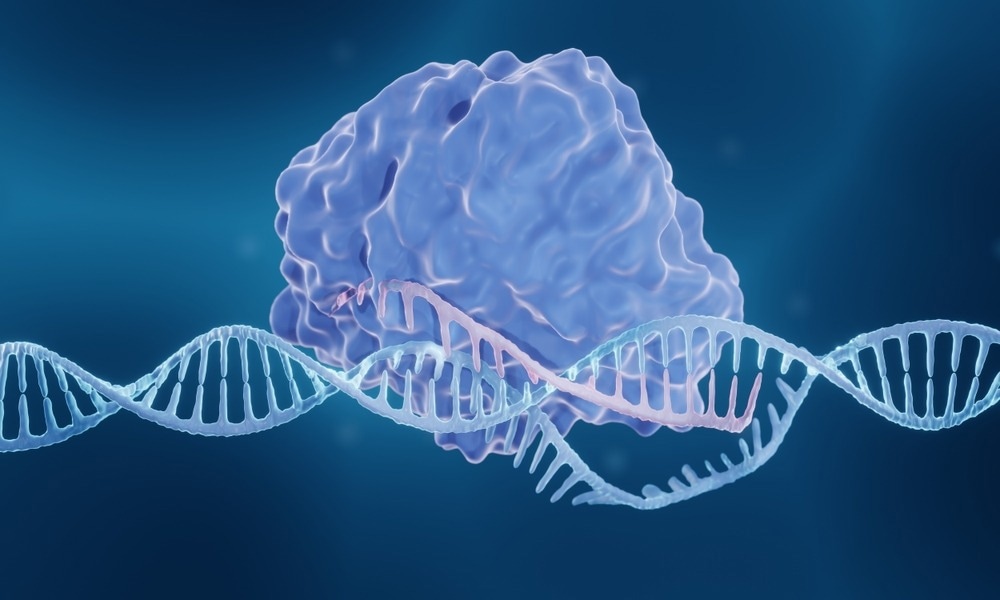Gene silencing is a process through which diseases are managed or eliminated by controlling the gene expression of the faulty gene. This is a relatively new treatment, which first emerged in the 1990s, that has allowed treatments to be developed and trialed for previously incurable diseases like Alzheimer's and Huntington's diseases. This treatment is still in its infancy and has the potential to revolutionize medicine.

Image Credit: ART-ur/Shutterstock.com
Genes and Disease
The unique biological composition of a human being is neatly condensed in the genetic code. Only 1.1% of the human genome is comprised of coding genes, also known as exons. Areas in between exons are divided into introns and intergenic sequences.
These exons are transcribed into pre-mRNA and become mRNA (messenger RNA) once intronic sequences are removed, and the coding sequences are joined together. The mRNA then travels outside of the nucleus and attaches to ribosomes. The ribosomes read the mRNA, translating this into a string of amino acids that form the building blocks of proteins.
As a result, any mutations that occur within genes can have a detrimental impact on the proteins they produce and result in disease. Many diseases have a genetic cause. This cause could be the result of a gene with a mutation that causes the protein to be produced wrong so that it can no longer serve the function it is supposed to. Or the mutation can cause the gene to produce too much or too little protein.
Types of RNA
RNA is made of the same bases as DNA, with the exception of uracil standing in the place of tyrosine. It is single-stranded, which makes it more unstable than DNA. RNA interference (RNAi) is a natural process employed by the body to protect against viral infection and control gene expression.
Short strands of RNA called short interfering RNAs (siRNA) are introduced into the cell that binds to targeted mRNA of complementary sequences. Binding the mRNA prevents it from being read by ribosomes and translated into proteins. This causes the mRNA to be broken down, reducing an invading pathogen's expression. This process can be artificially manipulated to silence disease-causing genes.
Examples of Gene Silencing Techniques
RNA interference is a popular technique used to disrupt the expression of disease-causing genes by intercepting mRNA before translation. DNA is double-stranded, making it a very stable structure. mRNA is single-stranded, allowing another RNA sequence with some sequence complementation to bind. mRNA can only be translated into protein by a ribosome in a single-stranded state. The RNAs used in gene silencing techniques are artificially produced and dispensed as therapeutic interventions.
Antisense oligonucleotides (ASO)
Oligonucleotides are synthetic short polymers of DNA or RNA nucleotides, usually smaller than 25 nucleotides - oligo means 'few'. Their short size makes them useful to clinicians as they can be used to target very specific sequences. ASOs are used to alter mRNA to interfere with the next stage of translating the sequence into protein. They are structured to contain a region of complementation to the target sequence, followed by a chosen sequence of nucleotides to encourage alterations in the following mRNA sequence. This technique has already been used in spinal muscular atrophy and Duchenne muscular dystrophy therapies.
Short Hairpin RNA (shRNA)
shRNA refers to short sequences of RNA, around 20-25 base pairs. As the name indicates, these sequences feature a tight hairpin twist that causes the RNA to bend over and rejoin with itself, causing it to be double-stranded. A limitation of this technique is that shRNA must be transported into the cell via transfection using artificial bacterial or viral vectors. shRNA is already being integrated into cancer therapies.
The coding sequence for the shRNA is integrated into the genome of the host's cells. Transcription occurs via a polymerase enzyme. The resulting RNA sequence is processed similarly to pri-microRNA; ribonuclease enzyme Drosha processes it within the nucleus and endoribonuclease Dicer outside the nucleus. The RNA product is then incorporated into the cell's own gene-silencing machinery, the RNA-induced silencing complex (RISC). The antisense strand works as the guide strand to target complementary mRNA sequences, while the sense strand is degraded.
shRNA can be packaged into a plasmid within a bacterial strain. However, insertional mutagenesis will be required between the bacteria and the patient's cells for the shRNA to become active.
Viral vectors have also been developed to deliver shRNA. Insertional mutagenesis is avoided with adeno-associated viruses and adenoviruses as the shRNA can remain episomal within the virus and avoid being integrated into the viral chromosome. However, viral packaging genes are removed from adeno-associated viruses, so the virus is lost through cell division. An alternative to adenoviruses is the lentivirus; they integrate into transcribed regions of the host genome, and their effect is not lost through rounds of cell division. Integrase-deficient lentiviruses are an option to avoid the risk of insertional mutagenesis.

Image Credit: ART-ur/Shutterstock.com
CRISPR/Cas9 system
RNA interference systems target mRNA and do not achieve full gene knockout. They also have a degree of non-specificity and have been proven to have some activity on off-target sequences. Other systems to achieve full gene knockout have also been developed. The CRISPR/Cas9 system is favored over other techniques, such as zinc-finger nucleases (ZFNs) and transcription activator-like effector nucleases (TALENs).
The CRISPR/Cas9 (clustered regulatory interspaced short palindromic repeats) system is made of the Cas9 endonuclease and a short RNA sequence (~20bp) that is complementary to the target sequence. Cas9 binds to a sequence-specific area of the genome and produces a double or single-stranded break. These breaks prompt DNA repair via the non-homologous end joining (NHEJ) or homology-directed repair (HDR) pathways; genetic modifications can be added at this stage by providing a template sequence for repair.
This system was first identified in prokaryote gene silencing systems and was adapted to use in eukaryotic cells. Cas9 requires a protospacer adjacent motif (PAM) - a short region of 2-6 base pairs immediately following the target sequence. Binding efficiency is improved with the presence of an NGG motif within the PAM region.
Sources:
- Bernards R, Brummelkamp TR, Beijersbergen RL. shRNA libraries and their use in cancer genetics. Nat Methods. 2006 Sep;3(9):701-6. doi: 10.1038/nmeth921. PMID: 16929315.
- Voets O, Tielen F, Elstak E, Benschop J, Grimbergen M, Stallen J, Janssen R, van Marle A, Essrich C. Highly efficient gene inactivation by adenoviral CRISPR/Cas9 in human primary cells. PLoS One. 2017 Aug 11;12(8):e0182974. doi: 10.1371/journal.pone.0182974. PMID: 28800587; PMCID: PMC5553774.
- Paddison PJ, Caudy AA, Sachidanandam R, Hannon GJ. Short hairpin activated gene silencing in mammalian cells. Methods Mol Biol. 2004;265:85-100. doi: 10.1385/1-59259-775-0:085. PMID: 15103070.www.oligotherapeutics.org/.../
- Lombardo A, Genovese P, Beausejour CM, Colleoni S, Lee YL, Kim KA, Ando D, Urnov FD, Galli C, Gregory PD, Holmes MC, Naldini L (November 2007). "Gene editing in human stem cells using zinc finger nucleases and integrase-defective lentiviral vector delivery". Nature Biotechnology. 25 (11): 1298–306. doi:10.1038/nbt1353. PMID 17965707.
- silence-therapeutics.com/.../default.aspx
- Pratt AJ, MacRae IJ. The RNA-induced silencing complex: a versatile gene-silencing machine. J Biol Chem. 2009 Jul 3;284(27):17897-901. doi: 10.1074/jbc.R900012200. Epub 2009 Apr 1. PMID: 19342379; PMCID: PMC2709356.
Further Reading